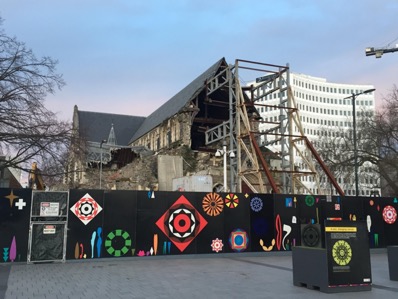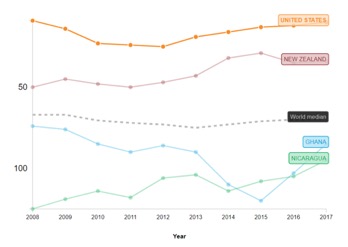
As a UP student, I have had several opportunities to learn about engineering projects around the world. After my sophomore year, I participated in a three-month internship with the Waiheke Resources Trust in Auckland, New Zealand, then traveled south to the city of Christchurch. In addition to this, I volunteered with an organization called Global Brigades on engineering projects in Ghana and Nicaragua.
Growing up in San Diego, California, I had access to relatively safe and reliable infrastructure. San Diego’s infrastructure isn’t perfect, but my global travels have revealed that many citizens of the U.S. have probably taken the benefits of a sound infrastructure for granted. During the summer after my sophomore year of college, I had the opportunity to work in New Zealand as an intern. I lived on a small island called Waiheke Island, approximately 50 kilometers from Auckland. The island was small enough that it did not have its own sanitary sewer system; instead the residents used septic systems, which was a technology unfamiliar to me. I was able to learn more about these systems through the work I completed as an intern.
During my time in New Zealand, I worked at the Waiheke Resources Trust (WRT). When the island was first inhabited, it was cleared of all its native bush for agricultural purposes. The main priorities of the Resources Trust were to restore the island’s native ecosystem and to minimize the impact of the island’s growing population on the island itself. As a part of these goals, I worked on two projects: Love Our Wetlands Waiheke and Project Little Oneroa. The Waiheke Resources Trust was funded by Auckland Council, the local government in the area, and the Trust provided Auckland Council with annual reports that described how the Trust was using those funds. Since these projects are a couple of years old, I updated the reports and their GIS maps for the 2016-2017 fiscal year.
Love Our Wetlands Waiheke is a project focused on improving the quality of the various wetlands across the island. In 2018, the WRT team was working in four different wetlands and was planning to move into two new wetlands in the next year. Throughout the past year, the WRT had weeded and replanted in multiple areas, so I updated the GIS maps that described how far along each wetland was in their restoration processes. As an intern, I also spent every Tuesday with the wetland restoration team removing invasive species. Being able to visit the sites was extremely helpful when mapping them digitally.
Project Little Oneroa focused on improving the Little Oneroa stream and watershed, which tested positive for e. coli. The stream flows onto a public beach and into the ocean, making the area unsafe for families and local residents. After testing for e. coli, the WRT started Project Little Oneroa to investigate the sources of the e. coli. They found that the contamination came from leaking septic systems. The next steps of the project focused on inspecting systems and comparing that data to the pollutant data. While I only visited some of these failing systems, I used notes from a WRT staff member to map the failing systems in a Global Information System (GIS) software. By mapping the current infrastructure, we were able to visualize the failing systems and how they impacted the entire watershed. From there, the WRT was able to accurately estimate the costs of replacing the failing systems and request funding from the local government to help homeowners replace their systems.
For my last two weeks in New Zealand, I traveled around both the north and south islands. After leaving Auckland, I was surprised to see that most of the country was sparsely populated and was largely agricultural. I also traveled down to Christchurch, the largest city on the southern island. In 2011, the city was hit by a 6.3 magnitude earthquake. Even in 2018, a large part of the city was still under repair and some structures had yet to be repaired. Their foundations had been exposed, showing crumbing footings and fractured columns. Pedestrian pathways and roadways still had large cracks from the quake and looked extremely hazardous.

In Christchurch, I visited a museum called Quake City. There, they explained the events that occurred during and after the earthquake, including different building technologies that were implemented after the earthquake. One of the most interesting technologies is called base isolation and it involves spring footings that allow the base of the building to move with the seismic waves of an earthquake. This type of construction is totally different from what is used typically in buildings resulting in less flexibility.
In addition to seismic upgrades, the construction around Christchurch (and most areas across New Zealand) are focused on sustainability. Many of the projects utilized recycled materials from fallen buildings and implemented technologies to improve stormwater collection, public transportation, and energy efficiency. Although the Christchurch earthquake destroyed the city, forcing many people to move, it allowed city planners to redesign a large portion of the city and make several improvements. Although still under construction, the city hopes to become the home some of New Zealand’s largest office buildings and the second largest population in New Zealand within the next decade.
During my time at the University of Portland, I was also able to travel to Nicaragua and Ghana with a program called Global Brigades. During these experiences, I was able to compare the United States infrastructure to that of those two countries. In Nicaragua, I stayed in Jinotega and worked in a rural community about an hour away. Jinotega had running water, sewer and electricity, but the rural community did not. Our work helped to provide the community with a water system. In Ghana, we worked in the Ekumpuano region and helped construct biodigesters, a system similar to small, self-maintaining septic systems. The community had a well to collect water and some homes had electricity, but open defecation was a huge problem because there was no sewer system.
In both countries, there was a difference in the infrastructure in urban and rural areas. Both capital cities had water, sewer, electrical, and transportation systems that seemed very similar to cities in the United States. However, even the large cities experienced shortfalls in their infrastructure. Accra, the capital of Ghana, would have frequent power outages due to shortages in the city’s power supply. Additionally, driving in Accra was nerve-wracking because its roads could not accommodate its population. At one point, our van was stuck in traffic. People were driving on both shoulders to try and get around traffic, until the shoulders were backed up too. Eventually, an ambulance tried to make its way through. Unable to use the shoulders, cars were moving into each other’s lanes to accommodate the ambulance. Situations like these are a reminder of the importance of making sure that infrastructure supports and keeps safe growing populations.
When venturing beyond the major cities, infrastructure and services are limited. Some communities have electricity, water, and sanitary systems, but if they do, they are shared between the community; they usually are not found in individual households. Even though rural areas in the United States may have smaller, more decentralized systems than large cities, services in rural areas are still constructed with specific standards designed to keep users safe. In both Ghana and Nicaragua, this is not the case and infrastructure is lacking.
The World Bank and the World Economic Forum rates different countries’ infrastructure. The United States is ranked in the top ten countries in regards to infrastructure and the World Economic Forum rated the U.S. a 6 on a scale of 7 (“Global Competitiveness Index 2017-2018”.) However, the U.S. also received a D+ rating from the American Society of Civil Engineers (ASCE), meaning that its infrastructure is in poor condition, reaching the end of its service life, and has a serious risk of failure (“America’s Infrastructure Grade”.) So, it means that most countries, including the United States, need to improve their infrastructure. The graph below shows the World Bank’s infrastructure ranking of the United States compared to a few countries that I have been able to visit and observe during my time as a Grand Challenge scholar: New Zealand, Nicaragua, and Ghana.

In Nicaragua and Ghana, people have relied on traditional practices, like collecting stream water and open defecation, instead of utilizing centralized water, wastewater, and transportation systems. These methods work, but can also create several public health issues. Even wealthier countries like the United States and New Zealand have infrastructure issues, as seen by ASCE’s Report Card and the devastation left seven years after the Christchurch earthquake. In the United States and New Zealand, current infrastructure must be maintained so that it is safe and can support growing populations. In countries like Ghana and Nicaragua, infrastructure should be developed so that their entire populations have access to clean drinking water, sanitary wastewater treatment, safe transportation systems, and reliable electricity.
“Global Competitiveness Index 2017-2018: Country/Economy Profiles.” World Economic Forum, World Economic Forum.
“America's Infrastructure Grade.” ASCE's 2017 Infrastructure Report Card, American Society of Civil Engineers.
“Quality of Overall Infrastructure.” TCdata360, The World Bank.